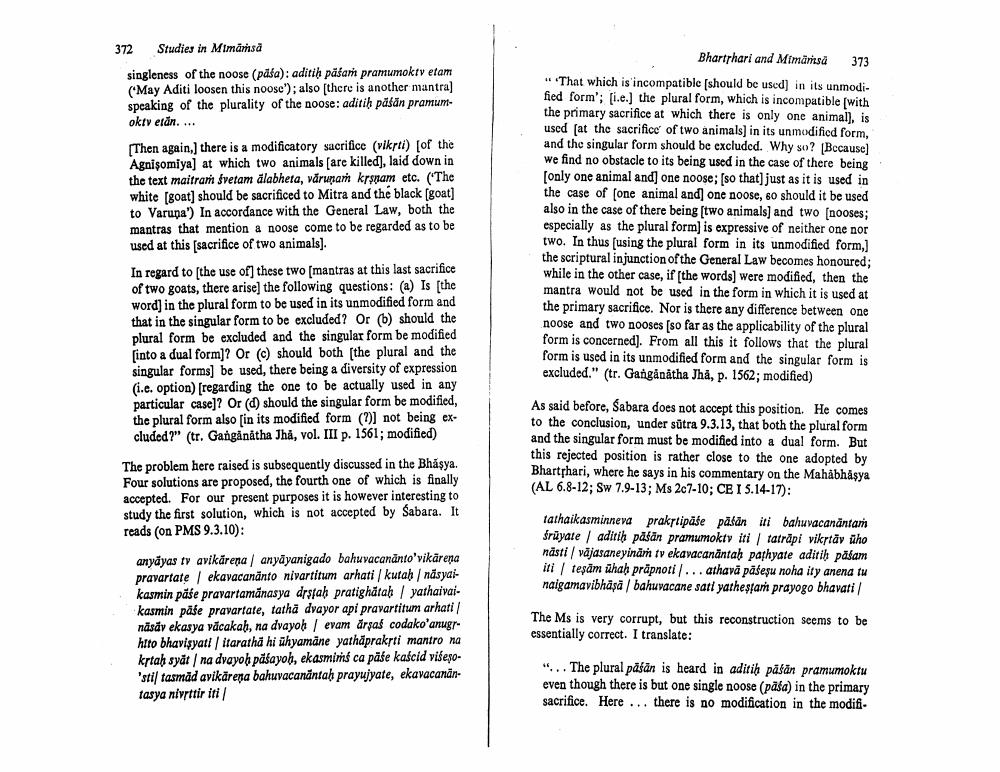Book Title: Bhartrhari And Mimamsa Author(s): Johannes Bronkhorst Publisher: Johannes Bronkhorst View full book textPage 2
________________ 372 Studies in Mimämsä singleness of the noose (paša): aditih pašam pramumok v etam ("May Aditi loosen this noose"); also there is another mantra) speaking of the plurality of the noose: aditih påsan pramum. okty etan.... [Then again, there is a modificatory sacrifice (vikrti) (of the Agnisomiya) at which two animals [are killed], laid down in the text maitram Svetam alabheta, vărunam krsnam etc. ("The white (goat] should be sacrificed to Mitra and the black (goat] to Varuna') In accordance with the General Law, both the mantras that mention a noose come to be regarded as to be used at this (sacrifice of two animals]. In regard to the use of these two (mantras at this last sacrifice of two goats, there arise] the following questions: (a) Is (the word) in the plural form to be used in its unmodified form and that in the singular form to be excluded? Or (b) should the plural form be excluded and the singular form be modified [into a dual form]? Or () should both (the plural and the singular forms] be used, there being a diversity of expression (i.e. option) [regarding the one to be actually used in any particular case)? Or (d) should the singular form be modified, the plural form also in its modified form (1) not being excluded?" (tr. Gangånátha Jhi, vol. III p. 1561; modified) Bharthari and Mimārsd 373 "That which is incompatible (should be used in its unmodified form'; [i.e.) the plural form, which is incompatible (with the primary sacrifice at which there is only one animal), is used (at the sacrifice of two animals) in its unmodified form, and the singular form should be excluded. Why so? (Because] we find no obstacle to its being used in the case of there being [only one animal and) one noose; (so that] just as it is used in the case of one animal and one noose, 60 should it be used also in the case of there being (two animals) and two (nooses; especially as the plural form) is expressive of neither one nor two. In thus (using the plural form in its unmodified form,] the scriptural injunction of the General Law becomes honoured; while in the other case, if(the words) were modified, then the mantra would not be used in the form in which it is used at the primary sacrifice. Nor is there any difference between one noose and two nooses (so far as the applicability of the plural form is concerned). From all this it follows that the plural form is used in its unmodified form and the singular form is excluded." (tr. Gangånátha Jhå, p. 1562; modified) As said before, Sabara does not accept this position. He comes to the conclusion, under sūtra 9.3.13, that both the plural form and the singular form must be modified into a dual form. But this rejected position is rather close to the one adopted by Bharthari, where he says in his commentary on the Mahâbhâsya (AL 6.8-12; Sw 7.9-13; Ms 2c7-10; CEI 5.14-17): The problem here raised is subsequently discussed in the Bhásya. Four solutions are proposed, the fourth one of which is finally accepted. For our present purposes it is however interesting to study the first solution, which is not accepted by Sabara. It reads on PMS 9.3.10): tathaikasminneva prakrtipāśe pädän iti bahuvacanäntar früyate / aditih pasan pramumokty iti tatrapi viktāv üho násti/ vajasaneyinām tv ekavacanäntah pathyate aditih pašam iti / tesām ühah präpnoti/...athava păseșu noha ity anena tu naigamavibhāsa / bahuvacane satt yathestar prayogo bhavati anyayas ty avikārena/ anyāyanigado bahuvacananto'vikarena pravartate / ekavacanänto nivartitum arhati / kutah/ năsyaikasmin påse pravartamānasya drstah pratighătah / yathaivaikasmin päse pravartate, tathā dvayor api pravartitum arhati/ nāsãy ekasya vācakah, na dvayoh / evam arsas codako'anugr hito bhavisyati/itaratha hi ühyamáne yathaprakrti mantro na krtah syāt na dvayoh pasayoh, ekasmimś ca pāśe kaścid viseso'stil tasmäd avikärena bahuvacanăntah prayujyate, ekavacanantasya nivpttir iti/ The Ms is very corrupt, but this reconstruction seems to be essentially correct. I translate: ".. The plural päsän is heard in aditih påśän pramumoktu even though there is but one single noose (pāša) in the primary sacrifice. Here ... there is no modification in the modifiPage Navigation
1 2 3 4 5 6 7 8 9 10
